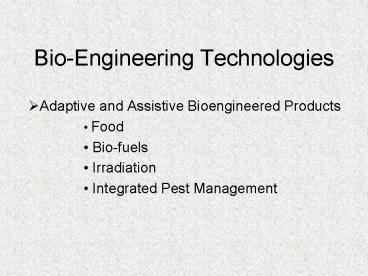Bio-Engineering Technologies PowerPoint PPT Presentation
1 / 13
Title: Bio-Engineering Technologies
1
Bio-Engineering Technologies
- Adaptive and Assistive Bioengineered Products
- Food
- Bio-fuels
- Irradiation
- Integrated Pest Management
2
Bio-Engineering is adivisions of Biotechnology
- Biology
- Chemistry
- Engineering
3
FOOD
BENEFITS ABOUT BIOENGINEERING
- Growth rate to maturity is increased making it
ready for market sooner - Desired qualities are sought more meat, better
taste, coloring, etc. (Customers at the
supermarket choose from products that appeal to
them) - Resistance to pests and/or disease
- Less reliance on pesticides and herbicides
- Less reliance on fertilizers
4
FOOD
CONCERNS ABOUT BIOENGINEERING
- Salmon have been bioengineered to grow five times
faster than wild breeds - What if animals with a different genetic
structure escaped and mated / competed for food
with wild stock? - Hens have been genetically modified to lay
low-cholesterol eggs - Chickens have been altered to produce anti-cancer
drugs - How will introduction of genetically altered
members of the same species of plant/animal
affect the balance in an ecosystem?
5
(No Transcript)
6
Bio-Fuels
- Ethanol (corn, sugar cane,cellulose)
- Biodiesel (soybeans, sunflowers, canola)
- Purified Biogas (plant residues or animal wastes)
- Biomethane Cow Power for Your Tank
- Used to replace or add to traditional
petroleum-based transportation fuels - Can be used in existing vehicles with little or
no modification to vehicle.
7
Bio-Fuels
- Benefits Sustainability Improves air quality
- Reduction of greenhouse gas emissions
Improves economy for farmers - Improves water quality
- Security of supply
- Biomass is currently the only source of renewable
liquid transportation fuels.
8
(No Transcript)
9
Irradiation
- Irradiation exposes food to radiant energy.
- Food is passed through an irradiator--an enclosed
chamber--where it is exposed to gamma rays
- Irradiated foods and their packaging are not made
radioactive.
10
Irradiation - Benefits
consumers, retailers, food manufacturers
- Provides an additional level of safety if food is
not fully cooked.
- Irradiation slows down the natural decay of fruit
and vegetables, EXTENDS SHELF LIFE.
- Irradiation contributes to keeping down food
costs as a result of less wastage and extended
shelf life.
11
Integrated Pest ManagementIPM
- Multi-tactic approach, joins several strategies
to get a particular pest. - Criteria for selecting a treatment strategy are
1. Least hazardous to human health 2. Least
disruptive of natural controls 3. Least toxic to
non-target organisms 4. Most likely to be
permanent 5. Easiest to carry out safely and
effectively 6. Most cost-effective 7. Most
site-appropriate
12
Control Strategies
- 1. Cultural control - uses fertilization, plant
selection, and sanitation to exclude problematic
pests and weeds. 2. Physical control - includes
creating barriers modifying conditions such as
temperature, light and humidity trapping and
manually weeding. 3. Biological control - uses
a pest's natural enemies. Introduces beneficial
insects or bacteria to the environment or, if
they already exist, provides them with the
necessary food and shelter and avoids using
broad-spectrum chemicals that will inadvertently
kill them. 4. Chemical control is used after
all other control strategies are deemed
inappropriate or ineffective. Target-specific,
low-toxicity pesticides are applied in a manner
that will maximize the effectiveness of pest
management and minimize the exposure to humans
and other non-target species. Spot treat if
possible to reduce exposure.
I n t eg r a t ed Pes t Managemen t
13
Question
- Some species of bacteria produce a substance that
is toxic to insects but harmless to humans.
Scientists have isolated the gene that controls
production of this substance. - Which of the following is the best reason for
inserting this gene into corn plants? - A. The corn will grow faster.
- B. Less fertilizer will be needed.
- C. Fewer pesticides will be needed.
- D. The corn will be more nutritious.

